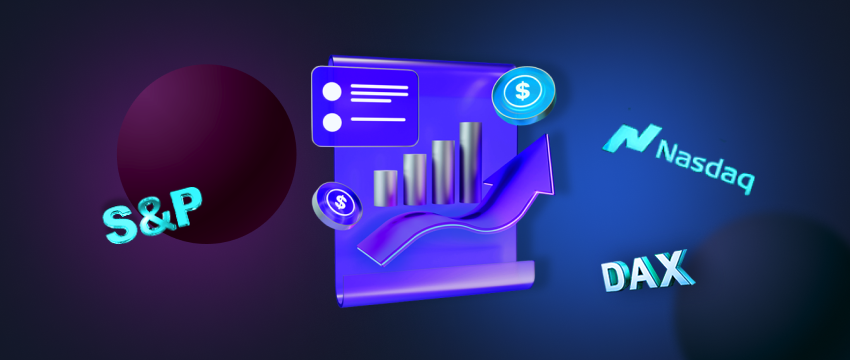To understand index trading, it’s important to first grasp what an index is. Simply put, an index is a collection of stocks or other assets grouped together based on certain criteria.
An index gauges the overall performance of a group of assets. Companies must meet specific criteria to join a particular index.
Some of the most well-known indexes in the U.S. are the Standard & Poor’s 500 (S&P 500) and the Dow Jones Industrial Average. These indexes track the performance of large companies in the U.S. stock market.
- The S&P 500® is one of the most reliable measures of large-cap U.S. equities. It tracks the stock market performance of 500 top companies listed on U.S. stock exchanges, representing about 80% of the total market capitalization.
- The Dow Jones Industrial Average (DJIA) tracks 30 major, publicly-owned blue-chip companies listed on the New York Stock Exchange (NYSE) and Nasdaq. Charles Dow and his business partner Edward Jones founded the index in 1896. Investors widely view the Dow 30 as a benchmark for the overall U.S. economy.

Other famous indexes across the globe include:
- The Financial Times Stock Exchange 100 Index, commonly known as the FTSE 100, FTSE, or informally the Footsie, is widely recognized as the leading stock market index in the United Kingdom. It represents the 100 largest blue-chip companies listed on the London Stock Exchange by market capitalization.
- The Nikkei 225, also called the Nikkei Stock Average or simply the Nikkei benchmark, is a price-weighted benchmark that operates in Japanese Yen. It represents the Tokyo Stock Exchange (TSE). The benchmark includes 225 well-capitalized, highly liquid publicly traded companies in Japan. These companies cover a wide range of industries and are reviewed biannually.
- The Euronext 100 Index is a stock index that features blue-chip companies listed on the pan-European exchange, Euronext. It includes the 100 largest and most actively traded stocks on the platform. To be eligible for inclusion, each stock must have at least 20% of its issued shares traded during the past year.
What do index traders do?
An index trader focuses on buying and selling financial instruments linked to the value of indices rather than individual stocks. Instead of trading specific stocks like NVIDIA, META, or Microsoft, an index trader will trade entire indices, such as the Dow Jones or S&P 500.
Index traders often prefer index trading because it tends to be less volatile and carries less risk compared to individual stock prices. One common method for trading benchmarks is by using CFDs (Contracts for Difference), which allow traders to speculate on the price movements of a benchmark without owning the underlying assets.
A CFD (Contract for Difference) is essentially an agreement between a broker and a trader, where the trader pays the difference in price between the opening and closing values of an index.
If the trader believes the value of the underlying asset, such as an index, will rise, they are likely to go long (buy). On the other hand, if they expect the value to fall, they may choose to go short (sell).
CFDs are popular as they are highly leveraged meaning the trader can open a larger position than what their account balance could normally accommodate.
This makes leverage particularly risky if a position moves unfavorably, as losses can be significantly amplified.
What impacts the value of an index?
The value of a stock index can be impacted by several factors.
Factor 1
Market values are influenced by economic indicators such as GDP growth, unemployment figures, inflation rates, and others. For example, stock markets typically rise when there is positive economic growth, while their value may decrease during an economic recession.
Factor 2
Secondly, the financial health of a company within an indicator may also influence that indicator’s value. If the company or group of companies reports disappointing earnings, the value of the indicator that groups those companies may decline, and vice versa.
Factor 3
Third, fluctuating prices of commodities also have the potential to influence the value of a stock index. For example, increasing copper prices may benefit mining sector stocks, positively influencing indices that include those companies. Conversely, falling commodity prices may have a negative effect.

Factor 4
Fourth, central bank announcements, especially those regarding interest rates, have a significant impact on index values. Higher interest rates can lead to reduced borrowing, which may cause stock index values to decline. Conversely, lower interest rates can stimulate borrowing and investment, potentially boosting index values.
Factor 5
Fifth, geopolitical instabilities or changes in government policies can affect a region’s business climate, leading to volatility in investor sentiment. This is particularly evident when tax rates or trade agreements change. Such shifts can positively or negatively impact the overall value of an index.
Similarly, pandemics or environmental disasters can disrupt supply chains, alter consumer demand, and create broader economic shifts. These events can significantly influence the value of specific indexes, especially those containing companies directly impacted by these occurrences.
Factor 6
Sixth, the strengthening and weakening of currencies may also cause the value of indexes to rise and fall.
A weakening local currency, for instance, may result in a decrease in investments within a particular index, causing its value to drop. A strengthening local currency will likely have the opposite effect.
Index Trader with effective risk management
As with any form of trading, especially strategies involving CFDs, which are usually highly leveraged, effective risk management is crucial to safeguard your capital.
Stop-Loss and Take-Profit Orders for Index Trader
There are many types of risk management techniques a trader can use.
Setting stop-loss orders limits losses by automatically exiting trades when traders reach a pre-established price level.
Take-profit orders work similarly by closing positions once traders reach a certain level, locking in gains.
Position Sizing and Diversification for index trader
In addition to these orders, traders can manage risk through position sizing by investing no more than 1-2% of their capital into a single position.
This helps prevent significant losses if the position performs poorly. Traders may also opt to diversify their portfolio, spreading their risk across multiple indexes rather than concentrating on just one.
Index Trader building a trading plan
Another valuable risk management technique, though less conventional, is creating a trading plan. Having a structured plan helps keep a trader focused and disciplined. A plan that includes dedicated time for continuous learning is also crucial.
An index trader must thoroughly understand the indexes they trade and the companies that make up those indexes. They should also stay mindful of the factors influencing both the value of the indexes and the performance of the individual companies within them. Taking the time to research and stay informed is essential for making well-informed trading decisions.

Become an Index Trader with T4Trade
T4Trade is a popular global broker with clients worldwide. The broker offers top-tier, 24/5 multilingual customer support, cutting-edge trading platforms, and flexible trading conditions.
T4Trade is also a great go-to resource for traders looking to learn more about forex trading in a user-friendly way.
A variety of videos, podcasts, eBooks, webinars, and videos-on-demand are curated by in-house specialists, catering to all types of traders.
T4Trade traders can also choose from a wide range of trading instruments across 6 asset classes, and enjoy flexible leverage, competitive spreads, fast trade execution and seamless deposit and withdrawal options.
Traders can also choose from multiple trading accounts that best suit their needs and individual preferences.
免责声明: This material is for general informational and educational purposes only and should not be considered investment advice or an investment recommendation. T4Trade is not responsible for any data provided by third parties referenced or hyperlinked in this communication.





